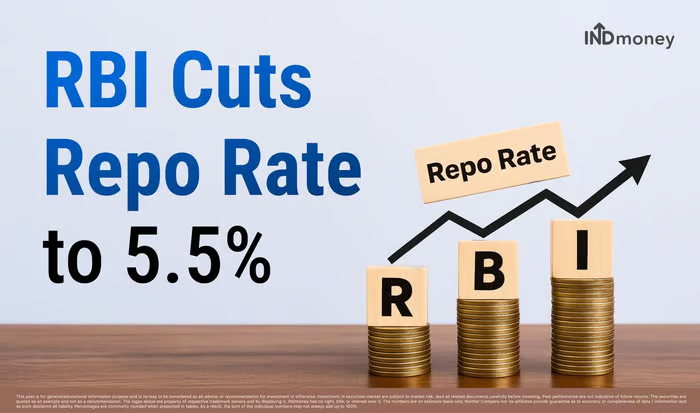In a much-anticipated decision, the Reserve Bank of India (RBI) has opted to maintain the repo rate at 5.5%, following its latest Monetary Policy Committee (MPC) meeting held from August 4 to 6. RBI Governor Sanjay Malhotra announced the outcome on Wednesday, stating that all six members of the MPC voted unanimously in favour of holding the rate.
Why the Repo Rate Matters
The repo rate is the interest rate at which the RBI lends short-term funds to commercial banks. It directly influences borrowing costs for individuals and businesses. A cut makes loans cheaper, while a hike makes them costlier.
Also Read:- Shweta Tripathi Buys Chic 3 BHK in Chembur’s Supreme Boulevard for ₹3 Crore
No Change in Rate – But Why?
This decision follows a 50-basis-point reduction in June, which brought the rate down to the current 5.5%. According to Malhotra, the RBI is taking a “wait-and-watch” approach, choosing to assess the impact of recent rate cuts on the domestic economy amidst global headwinds.
“After evaluating the macroeconomic and financial outlook, the MPC unanimously agreed to maintain the current policy rate under the Liquidity Adjustment Facility (LAF),” Malhotra said.
Inflation Under Control, But Caution Persists
The RBI’s stance is supported by signs of easing inflation—particularly in food prices—which are now within the central bank’s comfort zone for both the near-term and medium-term. However, the governor cautioned that headline inflation may rise later this year due to volatile food prices.
Also Read:- Aamir Khan Rents Four Ultra-Luxe Pali Hill Apartments Amid Redevelopment of His Own Building
Indian Economy: A Mixed Bag of Optimism and Risk
Despite persistent global trade disruptions, Malhotra expressed optimism about India’s economic trajectory, calling the outlook “bright”. That said, certain geopolitical developments could pose risks:
- The US is set to impose a 25% tariff on select Indian exports starting Friday.
- There’s also the threat of additional levies tied to India’s oil trade with Russia.
- Negotiations for a trade deal with the US are ongoing, but tensions remain high.
Rate Cuts So Far in 2025: A Quick Recap
With the repo rate already lowered by 100 basis points in 2025, analysts are divided on what’s next. While some expect limited further easing, others suggest that if inflation stays low and global challenges intensify, the RBI might consider another 50 bps cut.
Global Trends Also Influence RBI’s Stance
The RBI’s move also reflects broader international trends. For example, weak US jobs data has led to speculation that the Federal Reserve may cut rates in September. Markets currently price an 88% probability of such a move.
Also Read:- How Akshay Kumar Made ₹110 Crore by Selling His Flats and Offices in Mumbai
GDP Outlook Remains Steady – For Now
Despite potential challenges from higher tariffs and sluggish global trade, the RBI has retained its GDP growth projection at 6.5% for FY2025. However, some economists warn that India’s growth may lose up to 40 basis points if external trade tensions persist and dampen investor sentiment.
Conclusion: A Pause with a Purpose
The RBI’s decision to hold the repo rate steady signals a measured and cautious approach to monetary policy. With inflation currently manageable and global uncertainties brewing, the central bank is choosing stability over stimulus, while keeping the door open for adjustments based on how the economy evolves.
In a much-anticipated decision, the Reserve Bank of India (RBI) has opted to maintain the repo rate at 5.5%, following its latest Monetary Policy Committee (MPC) meeting held from August 4 to 6. RBI Governor Sanjay Malhotra announced the outcome on Wednesday, stating that all six members of the MPC voted unanimously in favour of holding the rate.
Why the Repo Rate Matters
The repo rate is the interest rate at which the RBI lends short-term funds to commercial banks. It directly influences borrowing costs for individuals and businesses. A cut makes loans cheaper, while a hike makes them costlier.
Also Read:- Shweta Tripathi Buys Chic 3 BHK in Chembur’s Supreme Boulevard for ₹3 Crore
No Change in Rate – But Why?
This decision follows a 50-basis-point reduction in June, which brought the rate down to the current 5.5%. According to Malhotra, the RBI is taking a “wait-and-watch” approach, choosing to assess the impact of recent rate cuts on the domestic economy amidst global headwinds.
“After evaluating the macroeconomic and financial outlook, the MPC unanimously agreed to maintain the current policy rate under the Liquidity Adjustment Facility (LAF),” Malhotra said.
Inflation Under Control, But Caution Persists
The RBI’s stance is supported by signs of easing inflation—particularly in food prices—which are now within the central bank’s comfort zone for both the near-term and medium-term. However, the governor cautioned that headline inflation may rise later this year due to volatile food prices.
Also Read:- Aamir Khan Rents Four Ultra-Luxe Pali Hill Apartments Amid Redevelopment of His Own Building
Indian Economy: A Mixed Bag of Optimism and Risk
Despite persistent global trade disruptions, Malhotra expressed optimism about India’s economic trajectory, calling the outlook “bright”. That said, certain geopolitical developments could pose risks:
- The US is set to impose a 25% tariff on select Indian exports starting Friday.
- There’s also the threat of additional levies tied to India’s oil trade with Russia.
- Negotiations for a trade deal with the US are ongoing, but tensions remain high.
Rate Cuts So Far in 2025: A Quick Recap
With the repo rate already lowered by 100 basis points in 2025, analysts are divided on what’s next. While some expect limited further easing, others suggest that if inflation stays low and global challenges intensify, the RBI might consider another 50 bps cut.
Global Trends Also Influence RBI’s Stance
The RBI’s move also reflects broader international trends. For example, weak US jobs data has led to speculation that the Federal Reserve may cut rates in September. Markets currently price an 88% probability of such a move.
Also Read:- How Akshay Kumar Made ₹110 Crore by Selling His Flats and Offices in Mumbai
GDP Outlook Remains Steady – For Now
Despite potential challenges from higher tariffs and sluggish global trade, the RBI has retained its GDP growth projection at 6.5% for FY2025. However, some economists warn that India’s growth may lose up to 40 basis points if external trade tensions persist and dampen investor sentiment.
Conclusion: A Pause with a Purpose
The RBI’s decision to hold the repo rate steady signals a measured and cautious approach to monetary policy. With inflation currently manageable and global uncertainties brewing, the central bank is choosing stability over stimulus, while keeping the door open for adjustments based on how the economy evolves.







